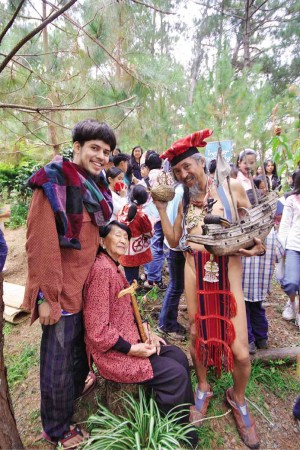Last of Baguio’s ‘3 Witches’ flies home

THREE GENERATIONS Virginia de Guia is flanked by grandson Kabunyan (left) and filmmaker-son Kidlat Tahimik, when they joined an Inquirer Read-Along activity in Baguio City.
In 1939, the box office of Manila’s prewar cinema, Fox, opened at 9 a.m. for a screening of the black-and-white film, “Nagkaisang Landas (United Destiny),” featuring matinee idol Rogelio de la Rosa.
But the movie poster gave De la Rosa second billing to the star, Lydia Leynes.
Baguio folk did not see Leynes when they paid their respect to her other incarnation, the city’s first and only woman mayor, Virginia “Gene” Oteyza-de Guia. At 98, De Guia died in her sleep on Feb. 9 in her Baguio home.
“Nagkaisang Landas” was a one-time cinematic experience for De Guia, whose life story was as colorful as the movies of her eldest son, filmmaker Eric de Guia, popularly known as Kidlat Tahimik.
Bombing survivor
Article continues after this advertisementIn one recollection she shared decades ago, De Guia said she survived the carpet bombing of Baguio by Allied Forces by seeking refuge inside the Baguio Cathedral toward the end of World War II.
Article continues after this advertisementAmerican bombers liberated Baguio from the Japanese Imperial Army by flattening the city, leaving only the cathedral standing.
This was the first time Baguio had to rebuild from ground up (the second was after the devastation from the 1990 Luzon earthquake). So to draw back people, De Guia said she helped design, coordinate and organize the city’s sights and events to drum up interest in the summer capital.
Baguio had followed De Guia’s lead after the quake when it established the Baguio Flower Festival 20 years ago.
De Guia was appointed acting mayor by then President Manuel Roxas in 1946 when then Mayor Jose Cariño became seriously ill.
Baguio scouting has also been associated with De Guia largely because of an already unspoken tragedy. In 1963, her second son, Victor de Guia Jr., and 23 other Filipino scouts, died in a plane crash at the Sea of Bombay in India en route to the 11th Boy Scouts World Jamboree in Marathon, Greece.
Public activists

‘WITCHES’ Former Baguio Mayor Virginia de Guia (left), together with the late local weekly editor Cecile Afable (center) and the late writer and educator Leonora San Agustin, fought to preserve Baguio City’s environment. PHOTOS BY EV ESPIRITU
To today’s politicians, De Guia was someone to fear, especially when she visited City Hall with community paper editor Cecile Afable and and writer Leonora San Agustin.
In the early 2000s, the three women became public activists who hounded Baguio officials who had imposed policies that threatened the city’s old skyline or which would displace the trees.
Wielding placards, the three women marched to block the construction of the Marcos Highway flyover, outraged that the government had designed it without consulting residents.
Kidlat gave them the name, “Three Witches,” as a joke, drawing references to fables and the storybook place of Oz. But time proved an enemy they could not defeat.
San Agustin, a former curator of the Baguio-Mt. Provinces Museum and the country’s first female chemical engineer, died in 2011. She was De Guia’s best friend since they were in Grade 2.
Afable, Midland Courier’s longtime editor, passed away in 2012.
De Guia had been in a wheelchair in the last few years, but she took an active part in recent Baguio events. She went quietly in her sleep, leaving behind children Kidlat Tahimik,Virginia and Patricia, eight grandchildren and 10 great grandchildren.
The last witch of the summer capital has flown proudly into wonderland and Baguio will forever grieve.